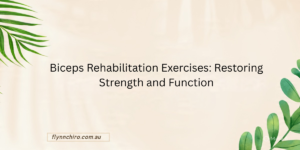
Common Causes Of Poor Posture And How They Affect Your Body
Most people don’t realise how much their posture affects them until the aches, tension, or fatigue set in. At my clinics in Melbourne CBD and Prahran, I often see patients who come in for neck or lower back pain, only to discover that the root cause is the way they hold themselves throughout the day.
Poor posture isn’t just about slouching. It’s about how your muscles, spine, and joints function together to support your body. And when that balance is off, everything from your energy levels to your digestion can suffer.
This article breaks down the most common causes of poor posture and explains how each one can impact your health so you can better understand what’s happening in your body and how to fix it.
Sedentary Lifestyles and the Impact of Technology

In today’s world, sitting is often the default. Whether at a desk, behind a steering wheel, or on the couch, we spend much of our day in seated, static positions. While the body is designed to move, it adapts quickly to how we use it. If you’re sitting for hours on end without proper support or movement breaks, your posture will gradually shift to accommodate that position usually in a way that leads to tight hip flexors, rounded shoulders, and a forward-leaning head.
Technology hasn’t helped. Staring down at your phone, laptop, or tablet for long stretches has led to a condition many now call “tech neck” a modern-day posture problem that places additional strain on your neck and upper back.
You don’t need to ditch the screen but being mindful of your body’s position while using one makes a significant difference.
Muscle Imbalances and Weakness

Posture relies heavily on your muscles working in harmony. But when some muscles become weak while others become tight, it throws your alignment off balance.
For example, if your core or upper back muscles are underused (which is common with long periods of sitting), they can no longer hold the spine upright effectively. Meanwhile, muscles like the chest or hip flexors, which are often in a shortened position, may become tight and overactive.
Over time, this imbalance results in typical postural issues such as an anterior pelvic tilt, swayback, or a stooped upper spine. These changes don’t just affect how you look they can change how you move, breathe, and even how efficiently your muscles fire.
Injuries and Structural Differences

Old injuries especially those that were never fully rehabilitated can contribute significantly to poor posture. For instance, a past ankle sprain may cause you to favour one side while standing, eventually leading to uneven hips or spinal compensation. Even minor car accidents or sports injuries can alter your gait and spinal loading patterns without you noticing until pain appears.
Additionally, some people are born with structural asymmetries like scoliosis or leg length discrepancies that affect alignment. While these aren’t always preventable, understanding them allows for more tailored chiropractic care and self-management.
Sleep Surfaces and Positioning
Many people overlook the impact of sleep on posture. You spend roughly one-third of your life asleep, so your mattress and pillow can either support healthy spinal alignment or work against it.
Soft or sagging mattresses may allow your spine to collapse during sleep, while pillows that are too high or too flat can misalign your neck. Poor sleep posture may not always cause discomfort immediately, but repeated nights in poor positions can add up over time.
It’s worth evaluating your sleep setup, especially if you wake with stiffness or pain that improves as the day goes on.
The Role of Stress and Emotional Tension
Posture is deeply connected to how we feel emotionally. Stress, anxiety, and low mood often show up physically in the form of muscle tension. People under chronic stress may hunch their shoulders, clench their jaw, or hold their breath without realising it. These tension patterns can become habitual, creating a body that is always on edge literally.
Chronic stress also affects breathing patterns, often encouraging shallow chest breathing rather than deeper belly breathing. This limits oxygen intake, increases fatigue, and further contributes to poor postural habits.
If you’re constantly tensing your shoulders or slouching under pressure, you’re not alone and it’s not all in your head. Your body holds onto emotional patterns, too.
How Poor Posture Affects the Body

Poor posture doesn’t only affect the spine it influences your whole system. Here’s how:
Musculoskeletal Strain and Joint Stress
When your alignment is off, certain joints and muscles are forced to compensate. This overuse often leads to pain in the neck, shoulders, and lower back. Over time, poor posture can cause disc compression, nerve impingement, or even premature joint degeneration.
Reduced Lung Capacity and Breathing Efficiency
Slouching reduces the space in your chest cavity, which restricts lung expansion. You may not even realise you’re taking shallower breaths, but your body certainly feels it. Many patients notice a boost in energy and calmness when their posture and breathing improve.
Digestive and Circulatory Disruption
Posture can also affect how your internal organs function. Compression in the abdominal area (common with slouched sitting) may slow digestion or contribute to bloating and reflux. Poor spinal alignment can also impact circulation and lymphatic flow, which may affect healing and immune response.
Mood, Focus, and Energy Levels
There’s a growing body of research linking posture to mental wellbeing. Upright posture is associated with increased alertness, confidence, and lower stress levels. On the flip side, slouching is often tied to fatigue and reduced cognitive sharpness.
Posture doesn’t just change how you feel it changes how your brain operates.
Prevention and When to Seek Help

Improving posture starts with awareness. Paying attention to your alignment, especially during long workdays, commutes, or phone use, is a great first step. Movement breaks, stretching, and core strengthening exercises can help re-train the body to hold itself in a healthier position.
However, if you’re experiencing pain, stiffness, or recurring tension, it’s worth getting a professional opinion. A chiropractor can assess your posture in detail, identify underlying issues, and help restore balance through targeted adjustments, muscle work, and customised advice.
At Flynn Chiro, I focus not just on relieving symptoms, but on understanding the patterns that created them so you can feel better long term.
Final Thoughts
Poor posture may seem like a small issue, but its impact is far-reaching. From muscle pain to breathing difficulties, digestive issues to fatigue, the way you hold your body matters.
The good news? It’s never too late to improve your posture. With the right approach and a bit of support, you can build habits that protect your spine, boost your energy, and improve how your whole body functions.
If you’d like a personalised posture assessment in Melbourne CBD or Prahran, I’d be happy to help.
👉 [Book Your Appointment at Flynn Chiro]

Flynn Pettersson
I am committed to providing exceptional chiropractic care in Melbourne, focused on your health and well-being.

Flynn Pettersson
I am committed to providing exceptional chiropractic care in Melbourne, focused on your health and well-being.






